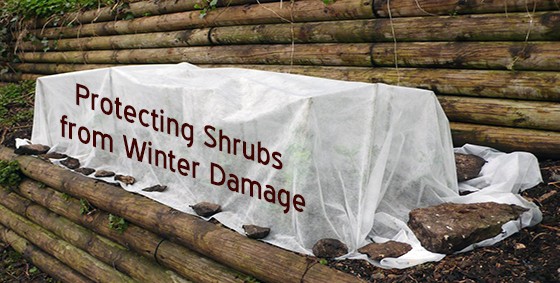
Winter weather can damage or kill shrubs and trees. Winter sun, wind and cold temperatures can dry out evergreen foliage and make it turn brown and die back. It can also damage twigs and dormant buds. The weight of snow and ice may break branches. Salt used to remove ice is not good for shrubs and trees. Wild animals adapt to winter food shortages by eating wood, bark and evergreen foliage in the winter. However it is possible to protect your garden shrubs and plants during the winter so that they will be in good shape come the spring. Here are a few tips to consider.
Winter sun and cold temperatures can make evergreen foliage turn brown and die back. There are a couple of things you can do to prevent this. First consider planting evergreens in places where they are not exposed to a lot of high winds and winter sun. After Christmas, place your old (natural) Christmas tree or evergreen branches around the shrub, this will act as a wind break.
Another option is to wrap the shrub in burlap or create a burlap barrier. Finally, make sure to water the shrub during the growing season, a well-hydrated shrub is less susceptible to drying out in the winter. Add a temporary layer of 6″ mulch (leaves, straw or wood chips) around the base, this keeps moisture in and prevents frost damage to the roots.
The weight of snow and ice can break branches or bend them away from the trunk. This can be prevented by wrapping the shrub with string or twine so that the branches are held in place even through heavy snowfall or ice storms. Remove the string promptly in the spring to allow the shrub to grow normally. Salt that is used to maintain roads in winter will damage the foliage or seep into the soil, damaging roots. If possible do not plant shrubs near the edge of the road or where salty water will drain. Existing shrubs can be protected with a burlap screen. Fortunately there are many trees, shrubs and plants that are resistant to salt and these would be a good choice for a roadside area.
There are several wild animals that are active in the winter months and when food is scare they will eat foliage, branches, twigs and bark that they ignore at other times of the year. It is important to protect the trunk from the ground up as well as higher branches/twigs that deer can reach. Mice and rabbits will gnaw the bark off the trunk and this can kill the shrub. To prevent this, wrap the trunk in chicken wire or metal mash fabric. Deer will eat small branches and twigs. If it is a low-growing shrub or tree seedling, they will eat it to the ground and kill it. To stop deer damage, either protect the shrub with a physical barrier such as a fence or burlap screen or use a chemical deer deterrent. Chemical deterrents need to be re-applied throughout the season after precipitation. Some people have had success using anti-bacterial soap hung from branches (inexpensive and lasts longer). Another thing to consider is choosing deer-resistant shrubs that deer avoid eating.
It is possible to prevent damage to shrubs and small trees during the winter. Plan for prevention by planting the right shrub in the right place and have your equipment and materials ready to use. Each winter, you will learn a little more about the unique requirements of your garden or yard. These preventative steps will ensure your shrubs are off to a good start the following spring.






Leave a Reply